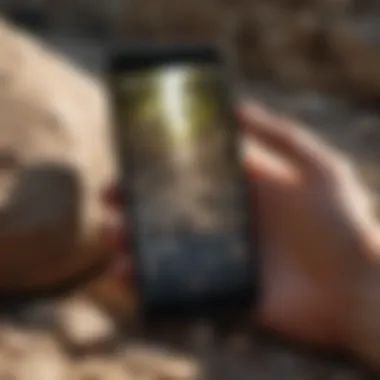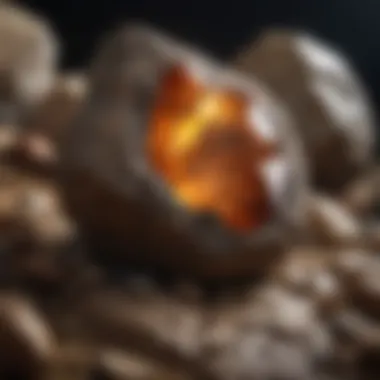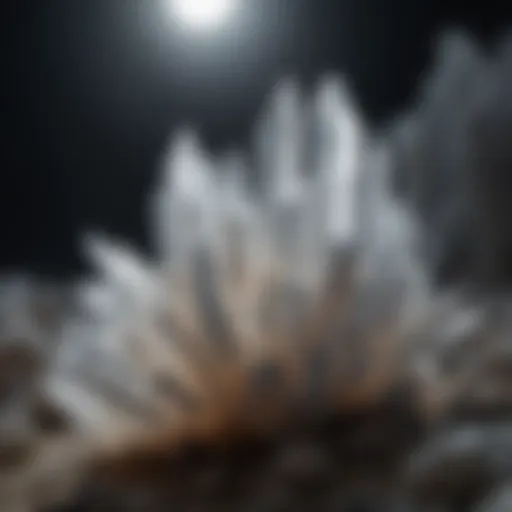An In-Depth Exploration of Stone Detector Apps


Intro
In recent years, the emergence of stone detector apps has transformed the approach towards rock and fossil collection. These applications are designed to assist collectors, educators, and outdoor enthusiasts in identifying and cataloging geological specimens. As technology evolves, the capability of these apps expands, providing users with invaluable tools to enhance their experience in the field. This article will delve into the intricate world of stone detector apps, highlighting their functionality, technological frameworks, and significance for both amateur and expert collectors.
Rock and Fossil Identification
Identifying rocks and fossils is the first step for any collector. Stone detector apps often incorporate features that streamline this process.
Types of Rocks and Fossils
Rocks are usually classified into three main types: igneous, sedimentary, and metamorphic. Each type has unique characteristics that set them apart:
- Igneous rocks form from cooled magma. Examples include granite and basalt.
- Sedimentary rocks result from the accumulation of particles and organic matter, such as limestone and sandstone.
- Metamorphic rocks arise from the alteration of existing rocks under pressure and heat, including schist and gneiss.
Fossils, on the other hand, are the preserved remains of ancient life. They can range from plant imprints to dinosaur bones. Understanding these categories is crucial for meaningful identification.
Characteristics to Look For
When utilizing a stone detector app, certain characteristics are essential in distinguishing between specimens. Key points to evaluate include:
- Color: The surface hue can provide initial hints about a rock's type.
- Texture: The feel, smoothness, and pattern contribute to accurate identification.
- Weight: Density can help classify igneous versus sedimentary rocks.
Tools for Identification
Stone detector apps typically utilize an array of tools to aid identification. These may include:
- Visual databases that display images and descriptions of various stones.
- GPS tracking to help locate collecting sites and track findings.
- Augmented reality features that overlay information on specimen images in real-time.
Collecting Tips and Techniques
While identification is essential, proper collection techniques ensure that fossils and rocks are retrieved safely.
Best Practices for Collecting
When exploring for geological specimens, it is crucial to follow best practices:
- Always conduct thorough research on sites to understand local regulations.
- Use appropriate tools such as trowels and chisels to extract specimens without damage.
- Document finds with images and notes for future reference.
Locating Prime Collecting Sites
Identifying the right location can significantly enhance your collection. Factors such as geological features, exposure of rock layers, and accessibility are important. Popular sites often include:
- Riverbeds, where erosion exposes fossils.
- Quarries, providing access to varied layers of rock formations.
- Beach areas, where natural weathering reveals hidden specimens.
How to Safely Extract Specimens
Using the right technique can prevent damage to both the specimen and the collector. Here are key points to consider:
- Assess the specimen's surroundings before attempting extraction.
- Use tools gently, applying minimal pressure to avoid breakage.
- Fill any holes created during collection to maintain the integrity of the site.
Preservation and Display
Protecting your specimens after collection is crucial for long-term enjoyment.
Techniques for Preserving Rocks and Fossils
Preservation techniques can vary based on the type of specimen:
- Using clear coatings can protect delicate fossils.
- For rocks, applying a varnish may enhance their appearance while providing a protective layer.
Proper Storage Methods
Effective storage is key to maintaining specimens:
- Store fossils and rocks in controlled environments, avoiding extremes in temperature and humidity.
- Use acid-free boxes and pouches for long-term storage, minimizing exposure to light.
Creative Display Ideas
Displaying your collection can be an art form:
- Consider shadow boxes to create attractive presentations for individual pieces.
- Use labeled stands to educate others about your specimens.
Geological Insights
A broader understanding of geological contexts can enhance the significance of your collection.
Geological Formations and Processes


Awareness of geological processes such as sedimentation, metamorphism, and volcanic activity informs the collector about the origins of each specimen.
Historical Significance of Rocks and Fossils
Each find may tell a story of its historical context, providing insights into ancient environments and biological histories.
Notable Discoveries in the Field
The field is rich with discoveries that reshape scientific understanding. Examples include significant fossil finds aiding in reconstructing evolutionary paths and exceptional rock samples that unveil details about Earth's geological past.
Stone detector apps are not just tools but gateways to greater understanding and appreciation of our planet's geological history.
As technology continues to advance, the potential for these applications in enriching the collector’s experience grows. Their role in educational contexts, from schools to museums, highlights the importance of engaging with geology on a deeper level.
Intro to Stone Detector Apps
The emergence of stone detector apps marks a significant development in the field of geology and rock collecting. As technology rapidly advances, these applications provide tools that enhance the discovery and identification of various stones and minerals. This section delves into the relevance of these apps, focusing on their transformative influence on both amateur collectors and professional geologists.
Stone detector apps use sophisticated algorithms and geo-location features to identify rocks and minerals with remarkable accuracy. They not only facilitate a deeper understanding of geological materials but also promote environmental awareness and responsible collecting practices. Furthermore, they serve as educational tools, bridging the gap between enthusiasts and foundational geological knowledge.
Defining Stone Detector Apps
Stone detector apps are mobile applications specifically designed to assist users in identifying and classifying stones and minerals. Using a combination of image recognition techniques and databases of geological data, these apps allow individuals to take a photograph of a rock, which the software then analyzes to provide information about its composition and characteristics. They often include features such as detailed descriptions, geographical distributions, and even user-generated findings.
In today's connected world, these apps are instrumental for collectors seeking reliable resources at their fingertips. With user-friendly interfaces, they cater to both novices and experts, allowing for easy navigation through features and functionalities. Many apps also integrate community feedback mechanisms, further enriching the user experience with shared knowledge.
The Evolution of Geological Technology
The development of geological technology has evolved considerably over the past few decades. Initially, geological studies relied heavily on manual identification methods and fieldwork, which were time-consuming and often inaccurate. With the advent of personal computers and later, smartphones, the landscape of geology saw a transformation.
Early applications focused primarily on educational content. However, with advancements in machine learning and database management, modern applications are now capable of real-time analysis and identification. Machine learning algorithms can learn from vast datasets, continually improving their detection accuracies.
The integration of augmented reality in recent years has further elevated these applications. Users can now point their phones at a rock or mineral and receive immediate feedback about its type and characteristics, bridging the gap between the virtual and physical worlds.
Core Features of Stone Detector Apps
Stone detector apps have become essential tools for a range of users, from amateur enthusiasts to professional geologists. Understanding core features helps users select the right application and maximizes its benefits. This section explores the main components that significantly impact functionality and user experience.
Detection Algorithms
Detection algorithms are vital to the effectiveness of stone detector apps. These algorithms analyze various data points, such as geological parameters, to identify rock types or fossils. The importance of accuracy in detection cannot be understated; users depend on precise results for both research and collecting. Many apps employ machine learning techniques which improve the system's ability to detect stones over time.
Key aspects of detection algorithms include:
- Real-time analysis: Instant feedback allows users to act quickly based on findings.
- Pattern recognition: Algorithms can identify specific rock types from images or readings, enhancing the overall experience.
- Customizability: Some applications allow users to input their preferences or rare stone types, providing personalized results.
User Interface Considerations
A well-designed user interface (UI) is critical for any app's success, and stone detector apps are no exception. An intuitive UI simplifies the user experience and allows users to navigate the app effortlessly, even when in the field.
Essential considerations for user interface include:
- Ease of use: Apps should be logically structured, with clear icons and instructions.
- Visual appeal: Aesthetic design can enhance user engagement and satisfaction.
- Accessibility features: Including options for those with visual impairments or other needs broadens the user base.
Data Management Capabilities
Data management functionalities reflect an app's ability to store, organize, and retrieve information related to geological findings. As users collect data about rocks and fossils, effective management becomes crucial for further analysis or sharing with peers.
Important elements of data management capabilities involve:
- Cloud storage integration: Users benefit from data being available across devices without loss of information.
- Export options: Being able to export data in different formats ensures researchers and collectors can share findings easily.
- Analytical tools: Some applications offer built-in tools for analyzing data trends, aiding users in recognizing patterns in their collections.
"Incorporating robust data management ensures that users maintain clarity and organization amid the complexities of geological data accumulation."
Overall, these core features work together to enhance the user experience in stone detector applications and facilitate accurate geological studies. Each element contributes uniquely to how effectively collectors can use these tools in their pursuits.
Technological Frameworks Supporting Apps
The technological frameworks that bolster stone detector apps are critical in shaping their functionality and reliability. These elements not only determine how efficiently the apps operate but also greatly influence user experience. As technology evolves, these frameworks must adapt, ensuring that the tools used by rock and fossil enthusiasts remain relevant and effective.
Machine Learning and AI Integration
Machine learning and artificial intelligence (AI) serve as foundational technologies in many stone detector apps. They allow for the processing of vast amounts of geological data, which can be used to refine detection algorithms. For instance, AI can analyze images of rocks and fossils, classify them, and suggest potential matches in databases.
This approach improves accuracy in identification and boosts the speed of analysis. The continuous learning aspect of machine learning means that these apps can improve over time. As users contribute more data, the algorithms enhance their predictive capabilities. A notable example is the Mindat app, which actively incorporates user-uploaded images to build a more comprehensive geological database.
Integrating machine learning also helps in recognizing patterns and trends that might not be visible to the human eye. By leveraging vast arrays of data, machine learning algorithms can indicate where specific types of rocks are more likely found based on historical data, geological surveys, and user reports.


Geo-Location Services
Geo-location services are another vital component of stone detector apps. These services utilize GPS technology to pinpoint the user's exact location. This capability allows collectors to map out their searches effectively, making the process of tracking down specific rocks or fossils more efficient.
For rock enthusiasts, a geo-located database can provide insights into local geological formations. Users can identify hotspots for particular specimens, ensuring that their efforts are directed where the likelihood of finding rare items is high. Furthermore, integrating geo-location with data management enhances the recording of collection locations, which is crucial for ongoing research and preservation.
Apps utilizing geo-location services not only make collecting more productive but also encourage responsible collecting. By documenting locations, users create a map of areas that have been searched, potentially reducing the risk of over-collecting in sensitive ecosystems.
Augmented Reality Applications
Augmented reality (AR) applications represent an exciting frontier in the realm of stone detector apps. By blending digital information with the real world, AR provides users with an interactive experience that enriches their exploration of geological specimens. Through the use of smartphones or AR glasses, users can visualize data about specific rocks or fossils as they point their devices at them.
This technology can include identifying mineral properties, geological dating, and even historical context. For instance, pointing a device at a specific rock formation could provide immediate information about its composition and formation process. Also, AR applications can showcase how different rocks form under various conditions, offering educational insights that are both engaging and informative.
Moreover, AR can facilitate collaborative learning experiences among users. Rock and fossil collectors can share their findings, allowing others to see the same specimens through their devices, thereby fostering a vibrant community of geological enthusiasts.
"Integrating advanced technologies like AI, geo-location, and AR transforms the way collectors engage with geological science, creating an interactive and informed experience."
Applications in Geological Studies
The role of stone detector apps in geological studies is becoming increasingly vital. These applications offer practical tools that enhance various facets of geological investigation. They not only support professional geologists but also empower amateur rock enthusiasts by streamlining the processes involved in classification and research. By implementing modern technology, these apps transform how users gather, organize, and analyze geological data.
Field Research Enhancements
Field research can be complex and demanding. Stone detector apps simplify many time-consuming tasks. For example, they provide real-time data collection, allowing geologists to capture essential information on the spot. Users can record their findings with photographs and GPS tags. This immediacy aids in creating accurate records of rock samples and fossil locations.
Furthermore, many apps integrate with satellite imagery and mapping services. This feature helps researchers visualize geological formations before arriving at the site. It can increase efficiency during field studies, making it easier to locate significant geological structures.
In addition, these applications may offer analysis tools. For instance, rock identification features help users recognize types of stones using built-in databases. This provides on-ground support for professionals who may face challenges classifying finds in the field.
Educational Tools for Geology Students
Stone detector apps serve as invaluable educational resources for geology students. These tools foster interactive learning and curiosity. Students can use the apps to engage with geological concepts actively. They might track their own findings and build an online portfolio of rocks or fossils they discover.
Many apps provide educational resources and quizzes that reinforce classroom learning. The gamification aspects of these applications can encourage deeper engagement. Users learn about geological processes while using technology they are already familiar with. This approach can make the subject more accessible and appealing, potentially leading to a higher interest in geology as a field of study.
Citizen Science Contributions
Citizen science is a growing movement, and stone detector apps play a pivotal role in it. They allow individuals to contribute to significant geological research. By collecting data and sharing findings with the broader scientific community, amateur collectors can aid in understanding geological diversity.
Apps often facilitate easy submission of findings to databases, enhancing the volume of data available for research. Collaboration between professional scientists and amateurs can result in valuable insights. For example, by integrating user-contributed geological maps, scientists can identify trends in rock distributions across various regions.
In summary, the applications of stone detector apps in geological studies are diverse and impactful. They enhance field research efficiency, support educational endeavors, and encourage community engagement through citizen science. These advantages promote a more informed public and deepen the collective understanding of geology.
"Using technology in geology not only advances academic knowledge but also nurtures a passionate community of amateur enthusiasts."
Impact on Rock and Fossil Collecting
The realm of rock and fossil collecting has seen significant transformations due to technological advancements. Stone detector apps, in particular, have emerged as valuable tools for enthusiasts and professionals alike. These applications enhance the collector's experience by facilitating knowledge acquisition, improving communication, and streamlining collection processes. The impact of such innovations shapes both the methodology and enjoyment of collecting, turning it into a more informed and interactive practice.
Improving Collector Knowledge
A major advantage of stone detector apps is their ability to enhance the knowledge base of collectors. These apps often incorporate various resources, including geological databases, educational content, and user-generated insights. This wealth of information empowers collectors to identify different rock types and fossils accurately. Additionally, users gain access to tutorials and guides that elucidate geological phenomena.
For instance, if a collector finds a rock, the app can provide immediate information regarding its classification, formation processes, and geological significance. Such knowledge plays a crucial role in fostering a deeper appreciation for the specimens collected.
Facilitating Communication Among Collectors
Communication stands as another vital aspect of the collecting community. Stone detector apps promote interaction between users, creating a sense of camaraderie among collectors. Many of these apps include features such as forums, chat options, and social media links, allowing individuals to share findings, ask questions, and offer advice.
Moreover, platforms like Facebook and Reddit provide dedicated spaces for discussing discoveries and techniques. This connectivity encourages knowledge sharing and collaboration, ensuring that both novice and experienced collectors benefit from each other's insights. Collectors can stay updated on local events, expeditions, and even trading opportunities.
Enhancing Collection Recording and Preservation
Accurate record-keeping is essential in rock and fossil collecting. Stone detector apps streamline this process by offering digital tools for tracking and managing collections. Users can log information about each specimen, including location, date of discovery, and any relevant observations. This digital approach reduces the likelihood of data loss that often occurs with traditional paper methods.
Furthermore, features that allow for the addition of images and detailed notes enable collectors to maintain comprehensive records. Preservation is also enhanced through the use of integrated geolocation services. By tagging locations, collectors can obtain valuable data about environmental conditions that may affect the preservation of their specimens.
"The integration of technology into collecting practices not only elevates the enjoyment but also ensures the integrity and value of the collections."
In summary, stone detector apps significantly influence rock and fossil collecting in various beneficial ways. By improving knowledge, facilitating communication, and enhancing collection recording, these applications offer collectors tools that deepen their relationship with the geological world. As technology advances, the potential for further enhancements in this field remains promising.
Challenges and Limitations
Understanding the challenges and limitations of stone detector apps is crucial for users who seek to maximize their effectiveness while minimizing pitfalls. These aspects underscore the necessity for a critical approach to app usage among collectors and researchers. Each challenge presents viable considerations that must be addressed to ensure accurate, reliable, and engaging experiences with these applications.
Data Accuracy and Verification Issues


Data accuracy plays a vital role in the functionality of stone detector apps. Users rely on accurate readings for identifying rock and mineral types. Any error in the data can lead to misclassification, which may affect collecting outcomes and educational pursuits. Even with advanced algorithms, factors such as environmental conditions and device quality can influence the precision of readings. Thus, the need for verification methods becomes essential. Users may seek cross-referencing with established geological databases or rely on expert opinions for confirmation.
Moreover, the data provided by these apps can sometimes prove incomplete or outdated. For example, if a stone detector app lacks comprehensive databases with new findings, users may struggle to identify modern finds effectively. Encouraging community input and feedback can facilitate continuous updates and improvements in data integrity.
User Accessibility Challenges
User accessibility is another significant challenge faced by stone detector app users. While mobile technology has become more widespread, not all individuals have equal access to it. Some users may not have smartphones capable of running advanced applications, while others may lack the digital literacy needed to navigate complex interfaces. This situation can alienate potential users, making it critical for app developers to design user-friendly interfaces that cater to all levels of expertise.
Also, there is the issue of multilinguistic support. A lack of language options may limit accessibility for non-native speakers. Providing multiple languages can enhance user experience and widen the app's reach. Striving for inclusivity is vital for ensuring a broader audience of geology enthusiasts.
Technological Dependence on Connectivity
The dependency of stone detector apps on internet connectivity presents a notable limitation. Many apps require access to the internet for real-time data processing or cloud-based storage. In remote areas where rock collecting often occurs, a weak or non-existent network connection can significantly hinder functionality. Users might find themselves without access to essential updates or data, which can detract from the overall experience.
To address this issue, developers could incorporate offline mode features. This would allow users to download essential data beforehand and access it without internet reliance. Implementing such features would enable greater flexibility in usage, ensuring that collectors can fully utilize the apps in diverse environments.
Future Trends in Stone Detector Technology
The domain of stone detector apps is evolving rapidly, influenced by advancements in technology and changing user expectations. Future trends will shape their functionalities and applications significantly. Understanding these trends is critical for rock and fossil collectors, as it will inform them of the best tools available to enhance their collecting experience. This section examines notable trends, focusing on advancements in affiliate technologies, integration with geological databases, and user-centric developments.
Advancements in Affiliate Technologies
Affiliate technologies are making significant strides, impacting how stone detector apps operate. New approaches to machine learning and computer vision are enabling these applications to detect stones with higher accuracy. Improvements in algorithms will allow for better identification of specific minerals and fossils. These advancements make apps more effective as tools for education and field studies.
Several companies are now focusing on developing software that can learn from user feedback. This creates a feedback loop where the app improves its functionality based on real-world use. Enhanced smartphone sensors and cameras are also pivotal in this progress, collecting and analyzing data in real-time.
Furthermore, the integration of drone technology could allow stone detector apps to cover more expansive geographical areas. Drones can capture high-resolution images of rocky terrains, which would then be analyzed through these applications. Better data leads to enhanced experiences for collectors.
Potential for Integration with Other Geological Databases
Integrating stone detector apps with existing geological databases opens significant possibilities. Access to centralized geological information can enhance the accuracy of stone detection and identification. By linking with databases such as the US Geological Survey or specialized repositories, apps can pull in crucial data about mineral composition, geographic distribution, and historical significance of finds.
This integration can facilitate real-time updates, allowing users access to the latest geological findings and research. It will empower collectors by providing context to their finds, promoting a deeper understanding of geological formations. The ability to share findings and data insights with a global community is also feasible, promoting collaboration among collectors and researchers.
"Collaboration and data sharing among stone enthusiasts can elevate the entire field of geology, making everyone a contributor to the collective knowledge of our planet."
User-Centric Developments
User-centric developments reflect a growing focus on enhancing the overall user experience. Developers are increasingly prioritizing features that cater to the needs of collectors. Customization options, ease of navigation, and education resources are becoming integral to app design.
Proponents of user feedback are pushing for iterative updates, ensuring the app evolves according to user needs. Enhancements in user interface (UI) aim to make navigation intuitive and efficient. Simplified designs with clear visual layouts reduce user frustration and increase engagement.
In addition, educational features, such as tutorials and information on stone types, are increasingly important for novice collectors. Apps that combine detection capabilities with educational content can serve as valuable tools for learning while collecting.
Case Studies of Successful Implementations
The relevance of this section lies in its ability to illustrate real-world applications of stone detector apps. Case studies provide concrete examples of how these technologies enhance geological work and collectibles. Through professional and amateur lenses, we can better understand the functionality and advantages that stone detector apps introduce. Case studies also highlight the practical impact on individual users and communities engaged in rock and fossil collecting.
Professional Geologists and Their Applications
Professional geologists are increasingly adopting stone detector apps in their work. These applications streamline processes, allowing geologists to efficiently document findings and analyze data in real time. An example is the use of the Rockd app, which facilitates the tagging and cataloging of rock specimens directly in the field. Geologists benefit from its built-in detection algorithms that identify rocks and minerals with a degree of accuracy.
Moreover, the integration of geo-location services allows geologists to track where samples are collected. This data becomes crucial for research purposes and helps in creating more accurate geological maps. A case study from the Appalachian region shows how a team of geologists utilized the app to monitor geological formations. They reported improved team collaboration and more reliable field data collection.
Additionally, the ability to share findings instantaneously enhances peer review processes. Professional geologists can relay their discoveries to colleagues or even the public, fostering better communication and transparency in geological research.
Amateur Collectors: Success Stories
Amateur collectors also show significant gains from using stone detector apps. One notable application is the Fossil Finder app, popular among hobbyists for its user-friendly interface and educational resources. One collector from California shared how this app transformed their fossil hunting trips. With the app's guidance, they learned to identify a variety of fossils previously unknown to them.
Collectors can log their finds, adding photos and notes, which creates a personal database of their collection. This is beneficial for tracking ownership and preserving details about each specimen. Furthermore, the app supports sharing with an online community, allowing users to receive feedback and assistance.
A survey among amateur collectors revealed that a large percentage reported increased confidence in identifying finds. Through workshops and forums integrated within these apps, hobbyists also connect with others who share similar interests. This collaborative aspect nurtures a vibrant community.
"Using stone detector apps not only enhances my collecting, but also connects me with fellow enthusiasts I would never have met otherwise." - A dedicated amateur collector.
In summary, both professional geologists and amateur collectors demonstrate how stone detector apps significantly aid in research and collecting. These case studies underscore the importance of technology in fostering knowledge and engagement within the geological community.
Culmination and Key Takeaways
As we conclude this exploration of stone detector apps, it is crucial to reflect on their multifaceted impact on both geological studies and the collecting community. Stone detector apps have emerged as valuable tools that merge technology with fieldwork, enabling users to analyze and classify stones effectively. These applications enhance the collector's experience by providing real-time data, allowing for informed decisions in the field.
Summary of Findings
The examination of stone detector apps has revealed several key findings. Firstly, the integration of machine learning and geo-location services facilitates accurate stone detection. Such technology is essential for both amateur and professional geologists in identifying and classifying various geological specimens. Secondly, user interface design plays a significant role in usability, making these apps accessible to a broader audience. A well-designed app accommodates diverse users, from seasoned geologists to hobbyists. Finally, the capability of data management within these apps ensures that information about collected stones is retained and organized, which is beneficial for future reference.
- Real-time Analysis: Users can analyze stones on the spot, leading to immediate insights.
- User Accessibility: The apps are designed to cater to both amateurs and professionals.
- Data Organization: Information is managed effectively, allowing for easy retrieval and analysis.
Implications for Future Research
Looking ahead, the implications of these stone detector apps for future research are significant. As the technology behind these applications continues to evolve, researchers should explore their potential to connect with larger geological databases. This integration could lead to a more comprehensive understanding of geological formations and foster collaboration across the scientific community. Furthermore, enhancing machine learning algorithms will improve the accuracy of detections, particularly as new stone types and fossils are uncovered.
"The challenge remains to ensure that these technological advances serve both educational and practical purposes in geology."
In summary, stone detector apps represent a convergence of technology and geological study that will likely expand in relevance, and contribute to informed collection practices in rock and fossil collecting. With ongoing innovations, the future is promising for both collectors and researchers.







